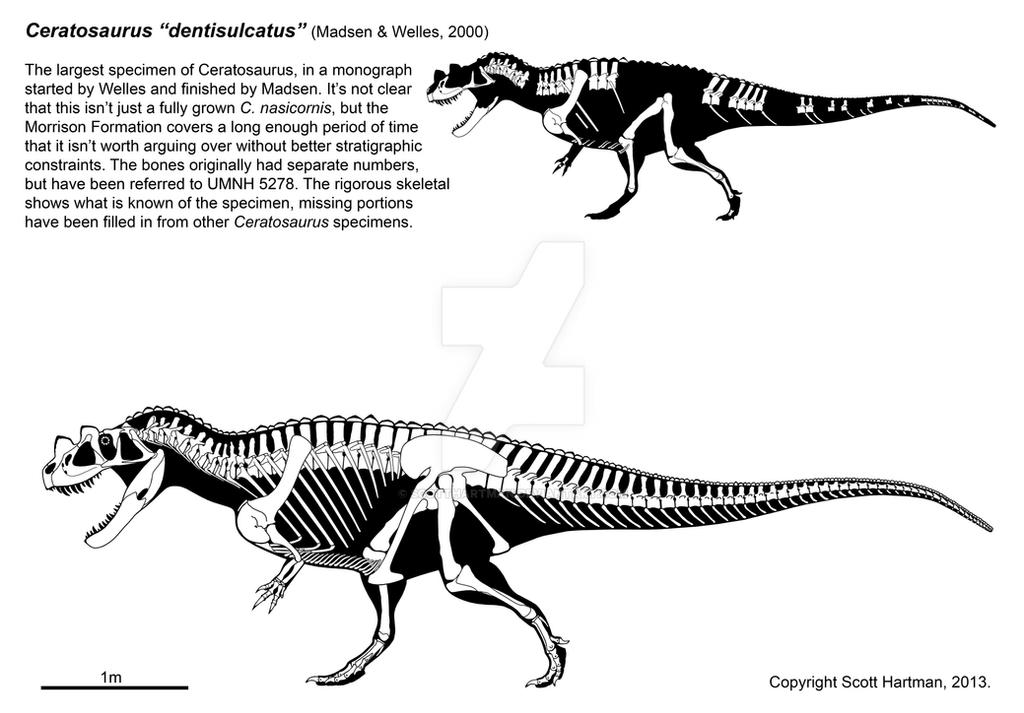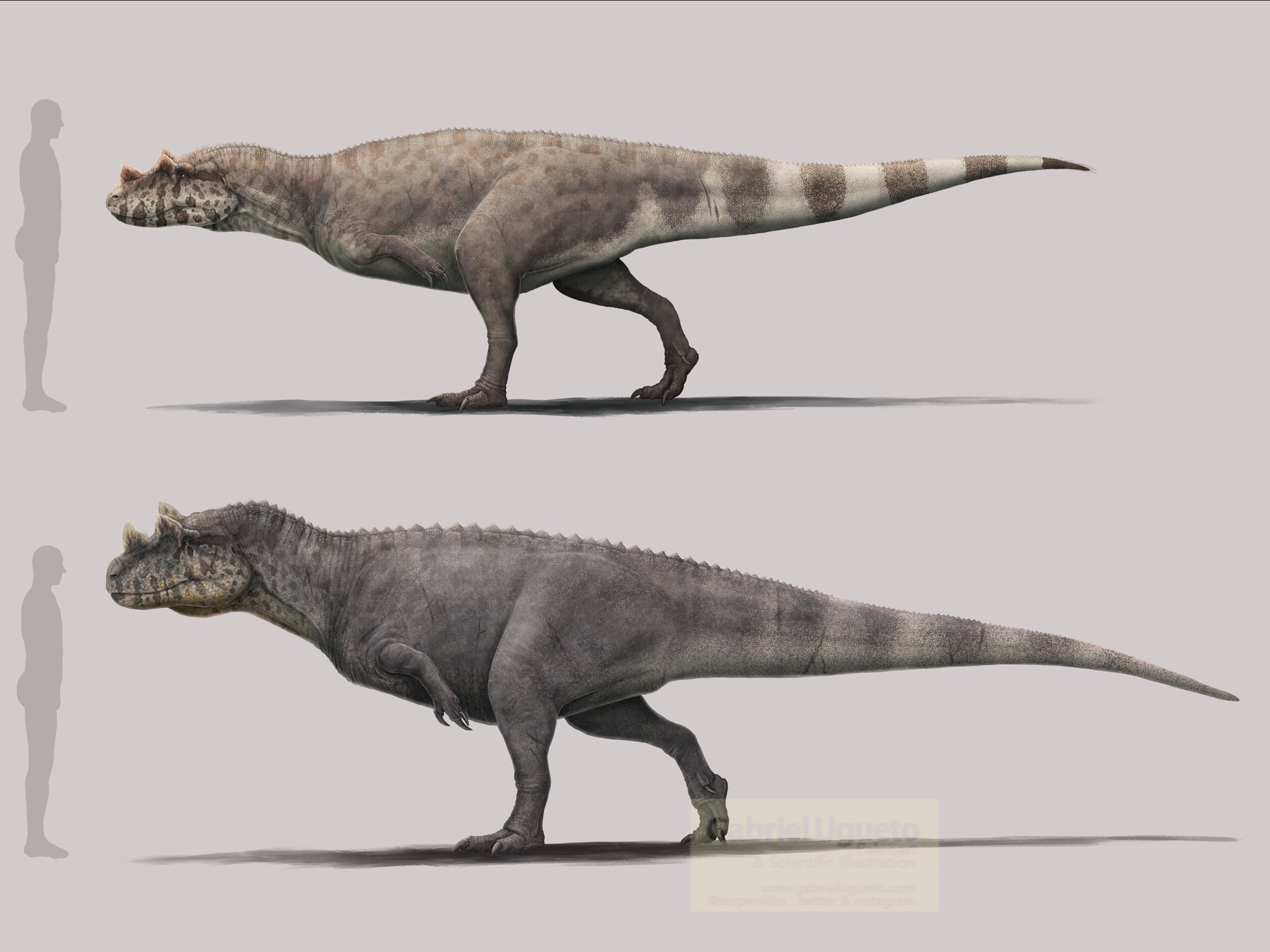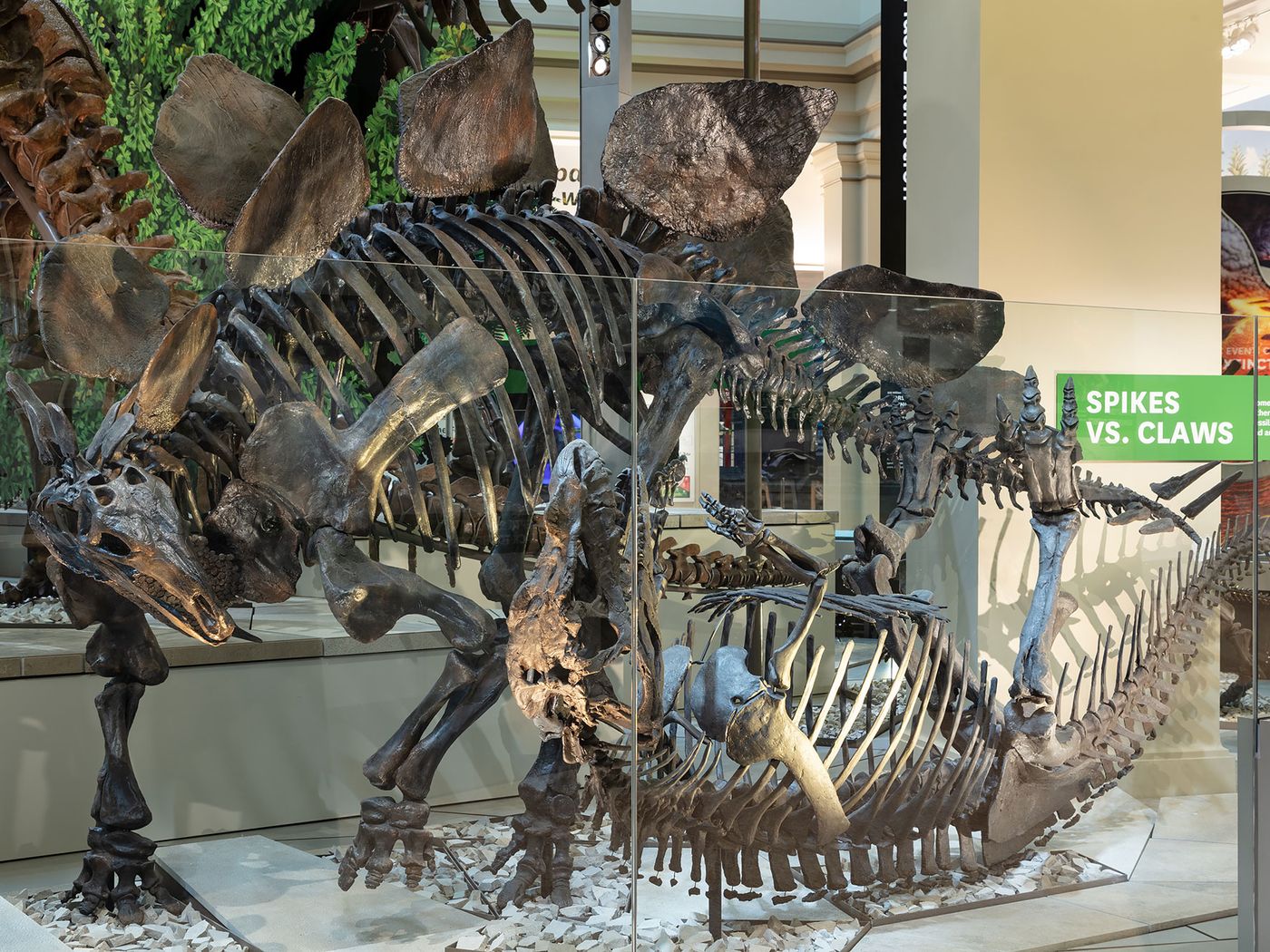Post by Vodmeister on Mar 19, 2014 22:56:44 GMT 5
Ceratosaurus spp.

Kingdom: Animalia
Phylum: Chordata
Clade: Dinosauria
Clade: Theropoda
Family: †Ceratosauridae
Genus: †Ceratosaurus
Ceratosaurus /?s?r?t??s?r?s/ meaning "horned lizard", in reference to the horn on its nose (Greek ??/
??/
 ?, keras/keratos meaning "horn" and
?, keras/keratos meaning "horn" and 
 /sauros meaning "lizard"), was a large predatory theropod dinosaur from the Late Jurassic Period (Kimmeridgian to Tithonian), found in the Morrison Formation of North America, and the Lourinhã Formation of Portugal. It was characterized by large jaws with blade-like teeth, a large, blade-like horn on the snout and a pair of hornlets over the eyes. The forelimbs were powerfully built but very short. The bones of the sacrum were fused (synsacrum) and the pelvic bones were fused together and to this structure (Sereno 1997) (i.e. similar to modern birds). A row of small osteoderms was present down the middle of the back.
/sauros meaning "lizard"), was a large predatory theropod dinosaur from the Late Jurassic Period (Kimmeridgian to Tithonian), found in the Morrison Formation of North America, and the Lourinhã Formation of Portugal. It was characterized by large jaws with blade-like teeth, a large, blade-like horn on the snout and a pair of hornlets over the eyes. The forelimbs were powerfully built but very short. The bones of the sacrum were fused (synsacrum) and the pelvic bones were fused together and to this structure (Sereno 1997) (i.e. similar to modern birds). A row of small osteoderms was present down the middle of the back.
Description
Ceratosaurus, at first glance, looked like a fairly typical theropod, however its skull was quite large in proportion to the rest of its body and possessed a prominent nose horn formed from protuberances of the nasal bones. In addition to the large nasal horn, Ceratosaurus possessed smaller hornlike ridges in front of each eye, similar to those of Allosaurus, these ridges were formed by enlargement of the lacrimal bones. Uniquely among theropods, Ceratosaurus possessed dermal armor, in the form of small osteoderms running down the middle of its back. Its tail comprised about half of the body's total length and was thin and flexible, with high vertebral spines.
The type specimen was an individual about 18 feet (5.5 m) long; it is not clear whether this animal was fully grown.[5][6] David B. Norman (1985) estimated that the maximum length of Ceratosaurus was 20 ft (6.1 m), an assessment supported by a particularly large Ceratosaurus specimen from the Cleveland-Lloyd Quarry (UMNH 5728), discovered in the mid-1960s, which may have been 22 ft (6.7 m) long assuming similar proportions to the holotype.
Marsh (1884) suggested that Ceratosaurus weighed about half as much as Allosaurus. In Predatory Dinosaurs of the World, published in 1988, Gregory S. Paul estimated that the C. nasicornis holotype skeleton came from an animal weighing about 524 kilograms (1,155 lb) while the large material from the Cleveland-Lloyd Quarry represents a much bigger and heavier individual, whose bulk he estimated at about 980 kilograms (2,160 lb).
The bigger specimen was later assigned by James H. Madsen and Samuel P. Welles to the new species C. dentisulcatus. A considerably lower figure was proposed by John Foster, a specialist on the Morrison Formation, in 2007. Foster used an equation provided by J.F. Anderson and colleagues to estimate mass from femur length, which yielded an approximate weight of 275 kilograms (606 lb) for C. magnicornis and 452 kilograms (996 lb) for C. dentisulcatus.
Discovery and species
Ceratosaurus is known from the Cleveland Lloyd Dinosaur Quarry in central Utah and the Dry Mesa Quarry in Colorado. The type species, described by O. C. Marsh in 1884 and redescribed by Gilmore in 1920, is Ceratosaurus nasicornis.
Two further species were described in 2000: C. magnicornis (from the Fruita Paleontontological Area, outside Fruita, Colorado) and C. dentisulcatus.[11] C. magnicornis has a slightly rounder horn but is otherwise highly similar to C. nasicornis; C. dentisulcatus is larger (over 7 meters), slightly more derived, and has an unknown horn shape (assuming it had them). The Portuguese remains have been ascribed to C. dentisulcatus (Mateus et al. 2000; 2006). However, the validity of C. magnicornis and C. dentisuclatus has been disputed by various palaeontologists,[12][13][14] arguing that the differences from C. nasicornis are due to individual or ontogenetic (age related) variation; thus, they would be junior synonyms of C. nasicornis. C. meriani is a nomen dubium.[15]
More additional species, including C. ingens and C. stechowi, have been described from less complete material. The former is now believed to be a dubious carcharodontosaurid instead, and the latter is a dubious ceratosaur and/or spinosaurid.[16] Ceratosaurus is present in stratigraphic zones 2 and 4-6 of the Morrison Formation.[17]
Classification
Relatives of Ceratosaurus include Genyodectes, Elaphrosaurus, and the abelisaurs, such as Carnotaurus. The classification of Ceratosaurus and its immediate relatives has been under intense debate recently. Ceratosaurs are unique in their characters; they share some primitive traits with coelophysoids, but also share some derived traits with tetanuran theropods not found in coelophysians. Its closest relatives appear to be the abelisaurs.
In the past, Ceratosaurus, the abelisaurs, and the primitive coelophysoids were all grouped together and called Ceratosauria, defined as "theropods closer to Ceratosaurus than to Aves". Recent evidence, however, has shown large distinctions between the later, larger and more advanced ceratosaurs and earlier forms like Coelophysis. While considered distant from birds among the theropods, Ceratosaurus and its kin were still very bird-like, and even had a more avian tarsus (ankle joint) than Allosaurus. As with all dinosaurs, the more fossils found of these animals, the better their evolution and relationships can be understood.
Distinguishing anatomical features
Close up of the head of a juvenile Ceratosaurus
A diagnosis is a statement of the anatomical features of an organism (or group) that collectively distinguish it from all other organisms. Some, but not all, of the features in a diagnosis are also autapomorphies. An autapomorphy is a distinctive anatomical feature that is unique to a given organism or group.
According to Rauhut (2000), Ceratosaurus can be distinguished based on the following features:[18]
1. a narrow rounded horn core centrally placed on the fused nasals
2. a median oval groove on nasals behind horn core
3. a premaxilla with three teeth
4. premaxillary teeth with reduced extent of mesial serrations
5. chevrons that are extremely long
6. a pubis with a large, rounded notch underneath the obturator foramen
7. small epaxial osteoderms
en.wikipedia.org/wiki/Ceratosaurus

Kingdom: Animalia
Phylum: Chordata
Clade: Dinosauria
Clade: Theropoda
Family: †Ceratosauridae
Genus: †Ceratosaurus
Ceratosaurus /?s?r?t??s?r?s/ meaning "horned lizard", in reference to the horn on its nose (Greek
 ??/
??/
 ?, keras/keratos meaning "horn" and
?, keras/keratos meaning "horn" and 
 /sauros meaning "lizard"), was a large predatory theropod dinosaur from the Late Jurassic Period (Kimmeridgian to Tithonian), found in the Morrison Formation of North America, and the Lourinhã Formation of Portugal. It was characterized by large jaws with blade-like teeth, a large, blade-like horn on the snout and a pair of hornlets over the eyes. The forelimbs were powerfully built but very short. The bones of the sacrum were fused (synsacrum) and the pelvic bones were fused together and to this structure (Sereno 1997) (i.e. similar to modern birds). A row of small osteoderms was present down the middle of the back.
/sauros meaning "lizard"), was a large predatory theropod dinosaur from the Late Jurassic Period (Kimmeridgian to Tithonian), found in the Morrison Formation of North America, and the Lourinhã Formation of Portugal. It was characterized by large jaws with blade-like teeth, a large, blade-like horn on the snout and a pair of hornlets over the eyes. The forelimbs were powerfully built but very short. The bones of the sacrum were fused (synsacrum) and the pelvic bones were fused together and to this structure (Sereno 1997) (i.e. similar to modern birds). A row of small osteoderms was present down the middle of the back.Description
Ceratosaurus, at first glance, looked like a fairly typical theropod, however its skull was quite large in proportion to the rest of its body and possessed a prominent nose horn formed from protuberances of the nasal bones. In addition to the large nasal horn, Ceratosaurus possessed smaller hornlike ridges in front of each eye, similar to those of Allosaurus, these ridges were formed by enlargement of the lacrimal bones. Uniquely among theropods, Ceratosaurus possessed dermal armor, in the form of small osteoderms running down the middle of its back. Its tail comprised about half of the body's total length and was thin and flexible, with high vertebral spines.
The type specimen was an individual about 18 feet (5.5 m) long; it is not clear whether this animal was fully grown.[5][6] David B. Norman (1985) estimated that the maximum length of Ceratosaurus was 20 ft (6.1 m), an assessment supported by a particularly large Ceratosaurus specimen from the Cleveland-Lloyd Quarry (UMNH 5728), discovered in the mid-1960s, which may have been 22 ft (6.7 m) long assuming similar proportions to the holotype.
Marsh (1884) suggested that Ceratosaurus weighed about half as much as Allosaurus. In Predatory Dinosaurs of the World, published in 1988, Gregory S. Paul estimated that the C. nasicornis holotype skeleton came from an animal weighing about 524 kilograms (1,155 lb) while the large material from the Cleveland-Lloyd Quarry represents a much bigger and heavier individual, whose bulk he estimated at about 980 kilograms (2,160 lb).
The bigger specimen was later assigned by James H. Madsen and Samuel P. Welles to the new species C. dentisulcatus. A considerably lower figure was proposed by John Foster, a specialist on the Morrison Formation, in 2007. Foster used an equation provided by J.F. Anderson and colleagues to estimate mass from femur length, which yielded an approximate weight of 275 kilograms (606 lb) for C. magnicornis and 452 kilograms (996 lb) for C. dentisulcatus.
Discovery and species
Ceratosaurus is known from the Cleveland Lloyd Dinosaur Quarry in central Utah and the Dry Mesa Quarry in Colorado. The type species, described by O. C. Marsh in 1884 and redescribed by Gilmore in 1920, is Ceratosaurus nasicornis.
Two further species were described in 2000: C. magnicornis (from the Fruita Paleontontological Area, outside Fruita, Colorado) and C. dentisulcatus.[11] C. magnicornis has a slightly rounder horn but is otherwise highly similar to C. nasicornis; C. dentisulcatus is larger (over 7 meters), slightly more derived, and has an unknown horn shape (assuming it had them). The Portuguese remains have been ascribed to C. dentisulcatus (Mateus et al. 2000; 2006). However, the validity of C. magnicornis and C. dentisuclatus has been disputed by various palaeontologists,[12][13][14] arguing that the differences from C. nasicornis are due to individual or ontogenetic (age related) variation; thus, they would be junior synonyms of C. nasicornis. C. meriani is a nomen dubium.[15]
More additional species, including C. ingens and C. stechowi, have been described from less complete material. The former is now believed to be a dubious carcharodontosaurid instead, and the latter is a dubious ceratosaur and/or spinosaurid.[16] Ceratosaurus is present in stratigraphic zones 2 and 4-6 of the Morrison Formation.[17]
Classification
Relatives of Ceratosaurus include Genyodectes, Elaphrosaurus, and the abelisaurs, such as Carnotaurus. The classification of Ceratosaurus and its immediate relatives has been under intense debate recently. Ceratosaurs are unique in their characters; they share some primitive traits with coelophysoids, but also share some derived traits with tetanuran theropods not found in coelophysians. Its closest relatives appear to be the abelisaurs.
In the past, Ceratosaurus, the abelisaurs, and the primitive coelophysoids were all grouped together and called Ceratosauria, defined as "theropods closer to Ceratosaurus than to Aves". Recent evidence, however, has shown large distinctions between the later, larger and more advanced ceratosaurs and earlier forms like Coelophysis. While considered distant from birds among the theropods, Ceratosaurus and its kin were still very bird-like, and even had a more avian tarsus (ankle joint) than Allosaurus. As with all dinosaurs, the more fossils found of these animals, the better their evolution and relationships can be understood.
Distinguishing anatomical features
Close up of the head of a juvenile Ceratosaurus
A diagnosis is a statement of the anatomical features of an organism (or group) that collectively distinguish it from all other organisms. Some, but not all, of the features in a diagnosis are also autapomorphies. An autapomorphy is a distinctive anatomical feature that is unique to a given organism or group.
According to Rauhut (2000), Ceratosaurus can be distinguished based on the following features:[18]
1. a narrow rounded horn core centrally placed on the fused nasals
2. a median oval groove on nasals behind horn core
3. a premaxilla with three teeth
4. premaxillary teeth with reduced extent of mesial serrations
5. chevrons that are extremely long
6. a pubis with a large, rounded notch underneath the obturator foramen
7. small epaxial osteoderms
en.wikipedia.org/wiki/Ceratosaurus
















